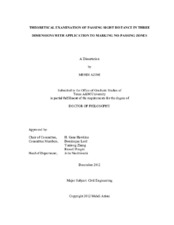Theoretical Examination of Passing Sight Distance in Three Dimensions with Application to Marking No-Passing Zones
Abstract
Rural two-lane highways constitute the majority of the road system in the United States. Over 62 percent of the Texas Department of Transportation (TxDOT) center line highway miles are two-lane highways. No-passing zones, which are indicated by solid lines separating the traffic moving in opposite directions, tell drivers where there are segments of two-lane highways that do not have sufficient sight distance to safely perform passing maneuvers.
This study describes a method for automating the process for locating no-passing zones using global positioning system (GPS) data. The author developed a new analytical algorithm to evaluate three-dimensional passing sight distances that will work for any arbitrary alignment of two-lane highway. The algorithm was incorporated into a computer model that uses GPS data as the input and results in the locations for no-passing zones. The steps involved in the process include collecting the GPS data, converting it to a form that models the roadway center line, evaluating the availability of passing sight distance, and determining the locations where no-passing zone markings should be placed. The resulting automated system processes GPS coordinates and converts them into easting and northing values, smoothes GPS data and evaluates roadway alignments for possible sight restrictions that indicate where no-passing zones should be located. The automated system was tested on three highway segments using two different GPS receivers, and the results obtained were in general agreement with the existing locations of no-passing zone markings. The verification results indicate that the algorithm and the computer program developed in this dissertation can be used to determine the availability of passing sight distance and locate no-passing zones.
Subject
Global Positioning System (GPS)Two-lane highway
No-passing zone
Three-dimensional sight distance
Citation
Azimi, Mehdi 1974- (2012). Theoretical Examination of Passing Sight Distance in Three Dimensions with Application to Marking No-Passing Zones. Doctoral dissertation, Texas A & M University. Available electronically from https : / /hdl .handle .net /1969 .1 /151617.


